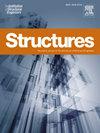Steel structural damage identification based on multisensor same-class graph and GraphSAGE network
IF 4.3
2区 工程技术
Q1 ENGINEERING, CIVIL
引用次数: 0
Abstract
Structural damage identification often faces challenges in extracting appropriate damage features when there are limited damage samples and noise interference, which can lead to a decrease in identification accuracy. This paper presents a steel structural damage identification approach based on a multisensor same-class graph and GraphSAGE network (MSC-GraphSAGE). Firstly, the spatial–temporal graphs of the data are established by Continuous Wavelet Transform (CWT). Then, the Laplacian matrix in graph theory extracts the features in each spatial–temporal graph. Multiple sensor spatial–temporal graph features are merged to construct a multisensor same-class graph to address the problems of poor model noise immunity and degradation of recognition performance for small sample datasets. Ultimately, the GraphSAGE network is utilized to classify the nodes in the multisensor same-class graph to identify the damage to the steel structure. The method in this paper is evaluated using the Steel Truss Bridge (STB) dataset and the Qatar University Grandstand Simulator (QUGS) dataset, and experiment findings indicate that the identification accuracy of MSC-GraphSAGE is superior and robust, and the recognition accuracy can reach 97.7% for the STB dataset and 99% for the QUGS dataset. With limited damage samples and noise interference, the identification results remain stable without significant fluctuation.
基于多传感器同类图和GraphSAGE网络的钢结构损伤识别
在损伤样本有限且存在噪声干扰的情况下,结构损伤识别往往难以提取出合适的损伤特征,从而导致识别精度下降。提出了一种基于多传感器同类图和GraphSAGE网络(MSC-GraphSAGE)的钢结构损伤识别方法。首先,利用连续小波变换(CWT)建立数据的时空图;然后,利用图论中的拉普拉斯矩阵提取每个时空图中的特征。为解决小样本数据集下模型抗噪能力差和识别性能下降的问题,将多个传感器时空图特征合并构成多传感器同类图。最后利用GraphSAGE网络对多传感器同类图中的节点进行分类,识别钢结构的损伤。利用钢桁架桥(STB)数据集和卡塔尔大学大看台模拟器(QUGS)数据集对本文方法进行了评估,实验结果表明,MSC-GraphSAGE具有较好的识别精度和鲁棒性,对STB数据集的识别准确率达到97.7%,对QUGS数据集的识别准确率达到99%。在有限的损伤样本和噪声干扰下,识别结果保持稳定,无明显波动。
本文章由计算机程序翻译,如有差异,请以英文原文为准。
求助全文
约1分钟内获得全文
求助全文
来源期刊

Structures
Engineering-Architecture
CiteScore
5.70
自引率
17.10%
发文量
1187
期刊介绍:
Structures aims to publish internationally-leading research across the full breadth of structural engineering. Papers for Structures are particularly welcome in which high-quality research will benefit from wide readership of academics and practitioners such that not only high citation rates but also tangible industrial-related pathways to impact are achieved.
 求助内容:
求助内容: 应助结果提醒方式:
应助结果提醒方式:


